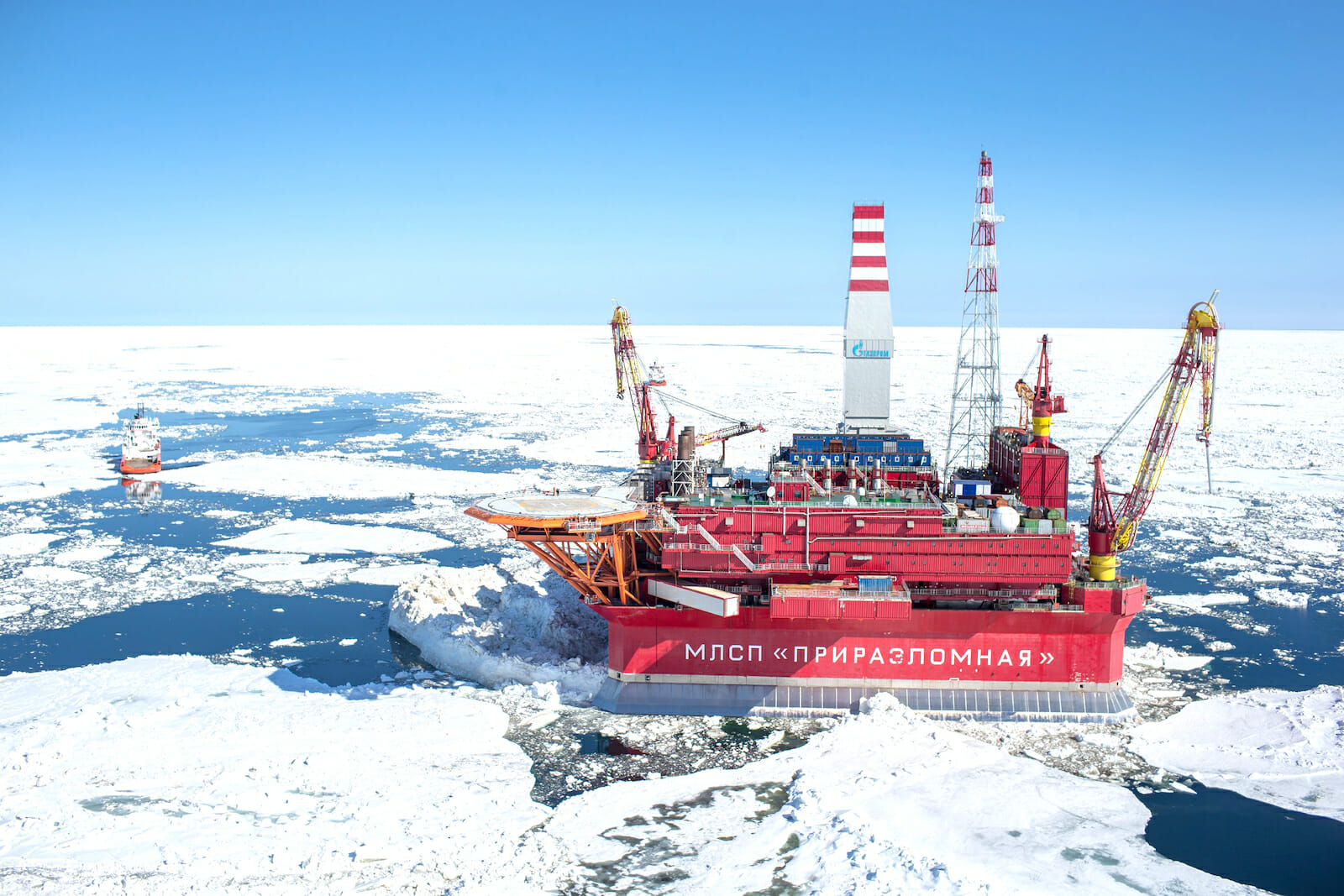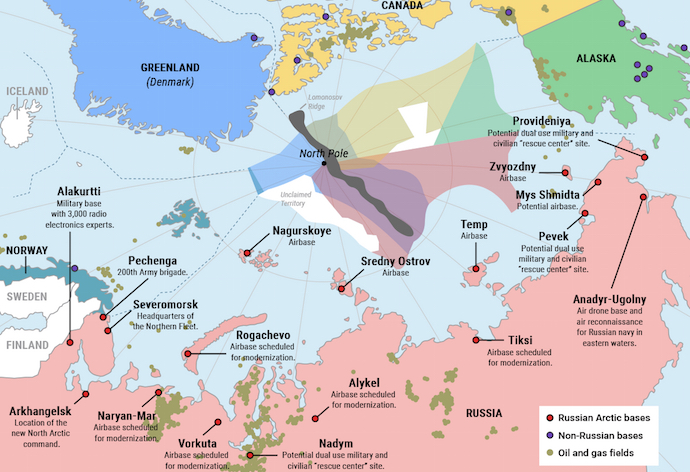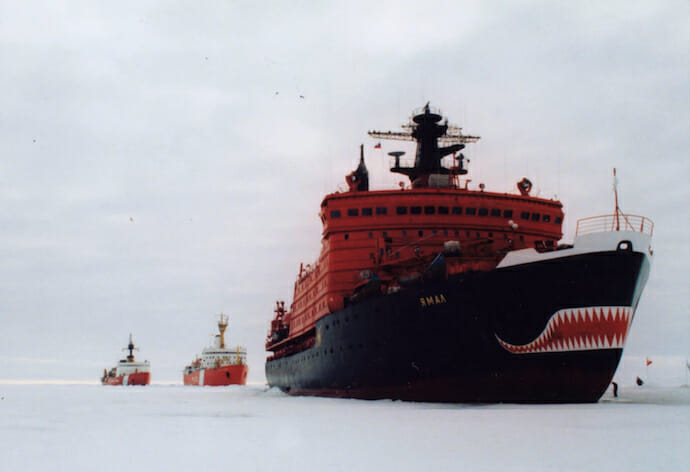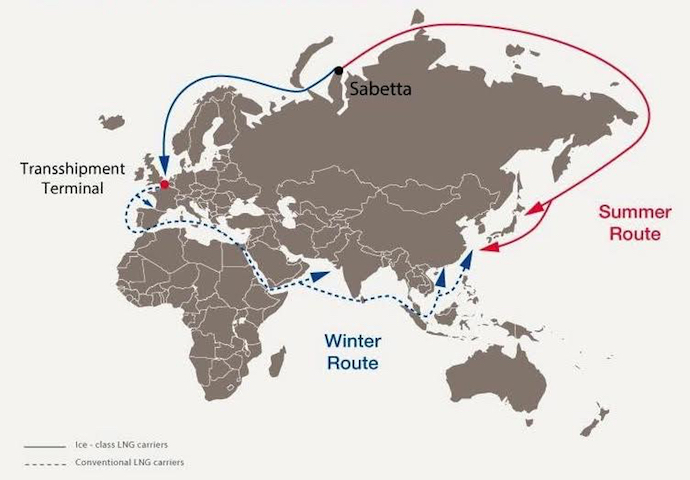
5 Ways Russia is Positioning to Dominate the Arctic
As many people across the United States are preparing to dig out of the heavy snow this weekend, in another snowy region, substantial preparations are underway. In the Arctic, Russia is making significant advances to advantageously position themselves for the future. Here are the five major actions Russia is taking in the Arctic.
1. Building More Bases
Russia is building and supporting more Arctic bases than any other country. The country’s Defense Minister, Sergey Shoygu, explained the moves saying that “a constant military presence in the Arctic and a possibility to protect the state’s interests by military means are regarded as an integral part of the general policy to guarantee national security…One of the Ministry’s prioritized areas is the development of military infrastructure in the region.” He went on to describe that the creation of Russia’s Arctic force and the distribution of “equipment with weapons for the whole Arctic” will be completed by 2018.
The overarching command structure for this new arctic force was created in December 2014 and was named Russia Joint Strategic Command North (JSCN). The command is based on the Northern Fleet and headquartered in Severomorsk. The surrounding area, referred to as the greater Murmansk region, is home to several bases where most of the Fleet’s 15+ submarines and approximately 40 ships are located, including Russia’s one aircraft carrier Admiral Kuznetsov. These Arctic bases are being expanded at a rate never before seen. Less than a 5-hour drive away from the Fleet’s Headquarters at Severomorsk is the Alakurtti base that has been significantly augmented and strengthened. It is only 30 miles from the border with Finland and is home to 3,000 personnel skilled in radio electronics. When the base improvements are complete, it will have an airfield, quarters capable of supporting a brigade of soldiers, and a large amount of new storage facilities that will house missiles and artillery ammunition.
Alakurtti is not the only base being built up; Defense Minister Shoygu said flatly, “We are not hiding this from anyone: we have practically finished building bases on the Novosibirsk Archipelago, the island of Kotelny Island.” Kotelny is a former USSR satellite military base that was abandoned with the collapse of the Soviet Union. It also happens to be one of the largest islands in the area and the site of a new massive Russian military base.
On the Eastern side of Russia, the Chukotka region has also been strengthened with a series of smaller bases on Wrangel Island (more colloquially known as the “home of the polar bear”), Cape Schmidt, the Kuril Islands, and others. And in the West, in October 2015, Russian officials announced that their massive base on the Franz Josef Land archipelago was 97 percent complete. This base sits along the 80th parallel or approximately 14 degrees further north than the Arctic Circle. Current plans are for the base to support 150 troops to live and operate there completely independent and unsupported for up to 18 months. And to support and defend their Arctic bases, Russia is also planning to build 13 airfields and at least 10 air-defense RADAR stations to be completed by 2017.
The map below illustrates Russia’s Arctic bases and how they are positioned to gain the upper hand in this burgeoning expanse.

2. Repositioning Troops to the Region
What good are bases if you do not have the troops to operate and defend them? Russia has augmented its forces by forming the relatively new Russian Arctic Brigade. The unit is comprised of two army brigades specially trained in Arctic warfare, the 80th Independent Motor Rifle Brigade in Alakurtti, and the 200 Independent Motor Rifle Brigade in Pechenga (both in the Murmansk area). Referring to the Eastern side of the country, Defense Minister Shoygu stated that, “Military troops deployment in Chukotka will make it possible to enhance the safety of the Northern Sea Route’s traffic and respond timely to potential military threats in the area.”
At the same time, Russia’s Arctic forces have also significantly increased their training and participation in exercises. In May 2015, their actions made headlines when in response to a NATO Arctic Challenge Exercise, Russia mobilized 12,000 troops and 250 aircraft; a massive response compared to the only 4,000 NATO troops taking part. The show of strength was clearly very integral to Russian ambitions in the Arctic. Russian Deputy Prime Minister Dmitry Rogozin responded to the mobilization saying, “It is our territory, it is our shelf, and we’ll provide its security. And we will make money there.” At the end of the day, having a robust and capable force is absolutely critical. According to a press statement from the Russian Navy, from 2014 to 2015 training exercises increased significantly, including amphibious landings by 300 percent, shooting training by 20 percent, and parachuting by 100 percent. Through these actions, Russia is positioning and training its military to be able to respond to any future threat in the Arctic.
3. Investing in Icebreakers
Russia is building the largest and strongest icebreaking fleet in the world. As of May 2015, they had at least 14 icebreakers under construction and more in planning. One of the designs, the 173 meter long LK-60, a nuclear-powered icebreaker, will be the largest icebreaker in the world (14 m longer than the current biggest) and will be able to break through ice three meters thick. Russia is planning to build at least two of these ships, with expected operational dates at the end of 2019 and end of 2020, respectively. Another design in the works is the LK-25, which will be the world’s largest diesel-powered icebreaker, capable of crushing through ice two meters thick. Overall, Russia has more than 40 icebreakers, significantly more than any other country. The United States, by comparison, has one operational heavy icebreaker in service, the Polar Star.

4. Investing in Arctic-Optimized Technology
Russia has made several significant investments in Arctic technology that will give them a leg-up in this harsh environment. On November 25, 2015, the first Arctic-optimized Mi-8AMTSh-VA helicopters were delivered to the Russian Ministry of Defense. The helicopters have several exceptional improvements to handle the extreme cold including powerful VK-2500-03 engines, Teflon hoses for hydraulics/fuel/oil, crew and cargo heating systems, specialized heating units specifically for the powerplant and rotor headgears, upgraded insulation, improved weather radar and navigation systems, and night vision equipment. All of these enhancements allow the aircraft to operate in marginal weather with low visibility where the temperatures may routinely reach below -40°С.
Another interesting innovation Russia is exploring is the possibility of mobile nuclear powerplants. Defense Minister Shoygu has “ordered pilot projects of mobile low-power nuclear stations to be mounted on a tracked vehicle or a sledged platform to be delivered where needed in the Arctic region.” They are designing these powerplants to be transported by military cargo jets or heavy cargo helicopters and to be fully autonomous and optimized for operation for a small number of personnel for several years at a time. On a parallel track, Russia is also developing the first floating nuclear power plant, which should be unveiled by October 2016 if everything goes according to schedule.
5. Constructing Natural Resource Infrastructure
A key reason for Russia’s investment in infrastructure is the increasing amount of access to natural resources in the Arctic. In order to achieve a competitive advantage in this evolving Arctic market, Russia has taken several important actions. First, they are building new energy plants like the Yamal LNG plant in the estuary of the Ob River. The $27 billion project is a joint venture supported by Russia’s Novatek, the French energy company Total, and China National Petroleum Corporation. The plant will have a total output of 16.5 million metric tons of Liquefied Natural Gas (LNG) per year.
Second, Russia is constructing 16 deep-water ports and at least 13 airfields that could be used to transport resources on the emerging new sea routes to markets throughout the world. The Yamal plant, for instance, will ship its LNG to Asian and European markets utilizing some of these ports along the route. The map below depicts some of the shipping routes that Russia is now utilizing from the port of Sabetta in the Yamal peninsula that will be increasingly relied upon as more ice melts in the Arctic.

So what does it all mean?
Russia’s most recent military doctrine was published on December 26, 2014. The document was significant because it announced the protection of “national interests in the Arctic” for the first time. This is particularly meaningful because Russia is strategically positioning itself as ice continues to melt in the Arctic, and additional sea routes are opened.
According to the United States’ National Snow and Ice Data Center (NSIDC), Arctic sea ice (as measured in September) has steadily declined from 1979 through 2014 at a rate of 13.3 percent per decade.
As the ice continues to melt, countries are licking their chops at what lies underneath the surface. According to estimates from the U.S. Geological Survey (USGS), the Arctic holds approximately 22 percent of the world’s undiscovered energy resources including 13 percent of the world’s undiscovered oil (90 billion barrels) and 30 percent of its undiscovered gas (50 trillion cubic meters of natural gas and 44 billion barrels of natural gas liquids). The vast majority of these resources, roughly 84 percent, are believed to lie offshore under the Arctic Ocean.
Eight countries have territory above the Arctic Circle – Canada, Denmark (Greenland), Finland, Iceland, Norway, the Russian Federation, Sweden, and the United States. According to international custom and practice, as espoused in Part V, Article 56 of the UN Convention on the Law of the Sea (UNCLOS), a country has sovereign rights to natural resources in the seabed up to 200 miles from their coastline, an expanse named the Exclusive Economic Zone (EEZ). Naturally, in a dynamic and ever-changing area like the Arctic, this has led to disagreements over which country has rights to a specific territory and the resources.
In August 2015, Russia submitted a claim to the UN for a large expanse of approximately 460,000 square miles of the Arctic Sea, including the North Pole, which directly conflicts with claims from other countries. This is not the first time Russia has made such an assertion. In 2002 they submitted a similar claim, however, the UN rejected it, citing “insufficient evidence.”
So as ice in the Arctic continues to melt and access to natural resources continues to increase, Russia is making the investments and the decisions now to position themselves for the future. More bases and troops in the Arctic will help them claim and defend territory and resources. Technological advances like arctic-optimized helicopters and mobile power plants will enable people to live, operate, and be transported throughout the Arctic with ease. New energy plants, deep-water ports, and airfields will enable resources to be shipped throughout the globe, and the world’s most powerful icebreakers will help clear the way. Russia is making these investments to not just operate in the Arctic, but to dominate it.
The views expressed in this article are those of the author alone and do not necessarily represent the Department of Defense or Department of State.

